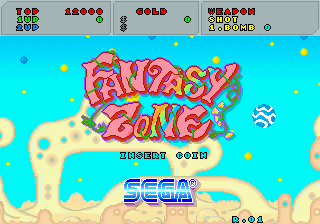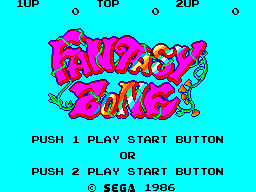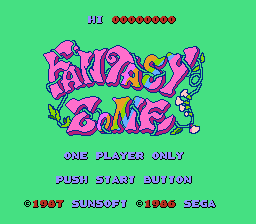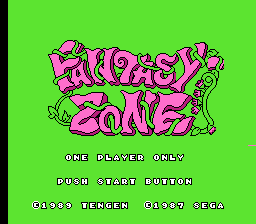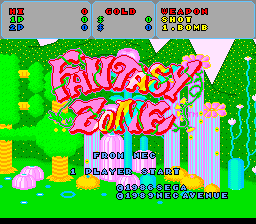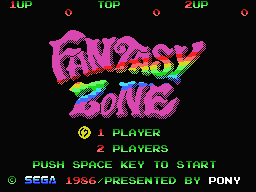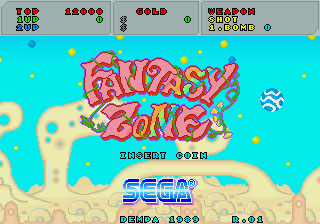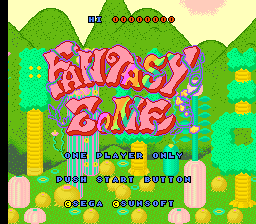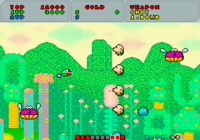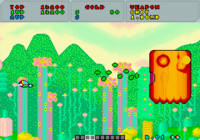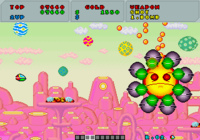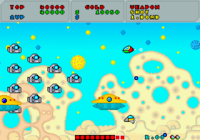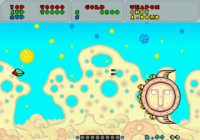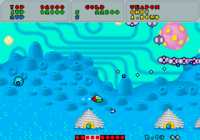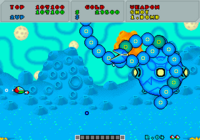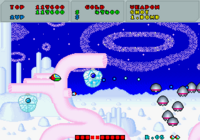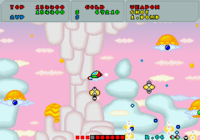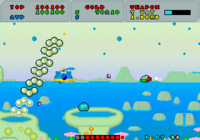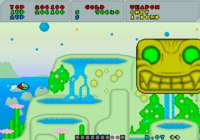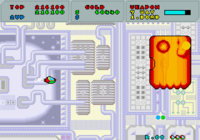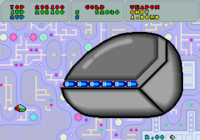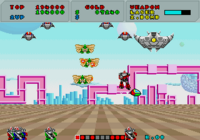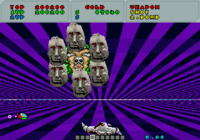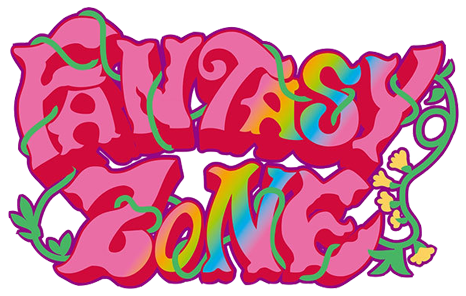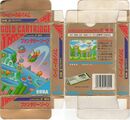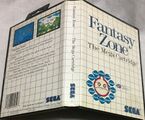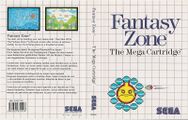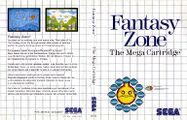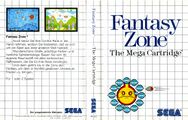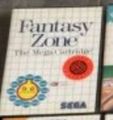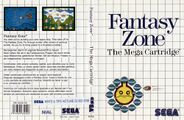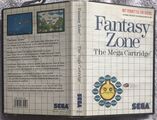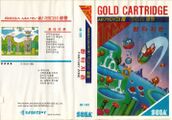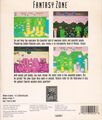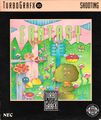Difference between revisions of "Fantasy Zone"
From Sega Retro
m (Text replacement - "Nintendo Famicom" to "Famicom") |
m (Text replacement - "Dempa" to "Dempa Micomsoft") |
||
| (47 intermediate revisions by 11 users not shown) | |||
| Line 1: | Line 1: | ||
| + | {{OtherPage|desc=other versions of the game with their own pages as well as similarly-titled media|page=Fantasy Zone (disambiguation)}} | ||
{{Bob | {{Bob | ||
| + | | logo= | ||
| bobscreen=Fantasy Zone Title.png | | bobscreen=Fantasy Zone Title.png | ||
| + | | bobscreen2=FantasyZone SMS Title.png | ||
| + | | bobscreen3=FantasyZone Famicom Title.png | ||
| + | | bobscreen4=FantasyZone NES Title.png | ||
| + | | bobscreen5=FantasyZone TG16 Title.png | ||
| + | | bobscreen6=FantasyZone MSX Title.png | ||
| + | | bobscreen7=FantasyZone_X68_JP_SSTitle.png | ||
| + | | bobscreen8=FantasyZoneNeoClassic title.png | ||
| + | | tab1=System 16 | ||
| + | | tab2=Master System | ||
| + | | tab3=Famicom | ||
| + | | tab4=NES | ||
| + | | tab5=TurboGrafx-16 | ||
| + | | tab6=MSX | ||
| + | | tab7=X68000 | ||
| + | | tab8=Neo Classic | ||
| publisher={{multicol| | | publisher={{multicol| | ||
{{company|[[Sega]]|system=SYS16, SMS|inline=no}} | {{company|[[Sega]]|system=SYS16, SMS|inline=no}} | ||
| − | {{company|[[Dempa]]|system=X68|inline=no}} | + | {{company|[[Dempa Micomsoft]]|system=X68|inline=no}} |
{{company|[[Sunsoft]]|system=FC|inline=no}} | {{company|[[Sunsoft]]|system=FC|inline=no}} | ||
{{company|[[Tengen]]|system=NES|inline=no}} | {{company|[[Tengen]]|system=NES|inline=no}} | ||
| − | {{company|[[NEC]]|system= | + | {{company|[[NEC]]|system=TG16|inline=no}} |
| − | {{company|[[NEC Avenue]]|system=PCE | + | {{company|[[NEC Avenue]]|system=PCE|inline=no}} |
{{company|[[Pony]]|system=MSX|inline=no}} | {{company|[[Pony]]|system=MSX|inline=no}} | ||
}} | }} | ||
| developer={{multicol| | | developer={{multicol| | ||
| − | {{company|[[Sega R&D 1]]|system=SYS16|inline=no}} | + | {{company|[[Sega R&D 1]]{{ref|https://web.archive.org/web/20200904154509/https://twitter.com/tsurumy/status/1301909105804677120}}|system=SYS16|inline=no}} |
{{company|[[Sega R&D 2]]|system=SMS|inline=no}} | {{company|[[Sega R&D 2]]|system=SMS|inline=no}} | ||
| − | {{company|[[Dempa]]|system=X68|inline=no}} | + | {{company|[[Dempa Micomsoft]]|system=X68|inline=no}} |
{{company|[[Sunsoft]]|system=FC|inline=no}} | {{company|[[Sunsoft]]|system=FC|inline=no}} | ||
{{company|[[Pixel]]|system=NES|inline=no}} | {{company|[[Pixel]]|system=NES|inline=no}} | ||
| − | {{company|[[Bits Laboratory]]|system=PCE|inline=no}} | + | {{company|[[Bits Laboratory]]|system=TG16, PCE|inline=no}} |
{{company|[[Pony]]|system=MSX|inline=no}} | {{company|[[Pony]]|system=MSX|inline=no}} | ||
| + | {{company|[[M2]]{{ref|https://www.mtwo.co.jp/development/retrogame-2/#tab-2}}|system=VC|inline=no}} | ||
}} | }} | ||
| − | | system=[[Sega System 16]], [[Sega Master System]], MSX, Famicom, Nintendo Entertainment System, TurboGrafx-16, [[X68000]], [[Virtual Console]] | + | | licensor={{company|[[Sega]]|system=FC,NES,MSX,X68,TG16,PCE}} |
| − | | players= | + | | system=[[Sega System 16]], [[Sega Master System]], [[MSX]], [[Famicom]], [[Nintendo Entertainment System]], [[TurboGrafx-16]], [[PC Engine]], [[X68000]], [[Virtual Console]] |
| − | | genre= | + | | players={{SYS16}}{{SMS}}{{TG16}}{{PCE}} 1-2 (alternating), {{FC}}{{NES}} 1 |
| + | | genre=Shooting{{ref|https://web.archive.org/web/20191231022720/https://sega.jp/history/hard/mastersystem/software.html}}{{fileref|FantasyZone SMS US cover2.jpg}} | ||
| releases={{releasesArcade | | releases={{releasesArcade | ||
| sys16_date_us=1986 | | sys16_date_us=1986 | ||
| sys16_date_jp=1986-03-28{{magref|mdfan|25|81|printpage=83}} | | sys16_date_jp=1986-03-28{{magref|mdfan|25|81|printpage=83}} | ||
| megatech_date_uk=19xx | | megatech_date_uk=19xx | ||
| − | }}{{releases | + | }} |
| − | | nes_date_us= | + | {{releasesPCE |
| − | | nes_date_jp=1987 | + | | pce_date_jp=1988-10-14 |
| + | | pce_code_jp=H49G-1001 | ||
| + | | pce_rrp_jp=4,900 | ||
| + | }} | ||
| + | {{releasesTG16 | ||
| + | | tg16_date_us=1989-11{{fileref|ComputerEntertainer US Vol.8 09.pdf|page=14}} | ||
| + | | tg16_code_us=TGX020017 | ||
| + | }} | ||
| + | {{releases | ||
| + | | nes_date_us=1990 | ||
| + | | nes_rrp_us=39.95{{magref|vgce|20|69}} | ||
| + | | nes_date_jp=1987-07-20 | ||
| nes_code_jp=SS8-5300 | | nes_code_jp=SS8-5300 | ||
| nes_rrp_jp=5,300 | | nes_rrp_jp=5,300 | ||
| − | |||
| − | |||
| − | |||
| − | |||
| − | |||
}} | }} | ||
{{releasesSMS | {{releasesSMS | ||
| − | | | + | | sms_date_jp=1986-06-15{{ref|https://web.archive.org/web/20191231022720/https://sega.jp/history/hard/mastersystem/software.html}} |
| − | | | + | | sms_rrp_jp=5,000 |
| − | | | + | | sms_code_jp=G-1301 |
| sms_date_us=1986-09{{magref|ce|5.06|13}} | | sms_date_us=1986-09{{magref|ce|5.06|13}} | ||
| sms_code_us=5052 | | sms_code_us=5052 | ||
| sms_type_us_1=Rerelease | | sms_type_us_1=Rerelease | ||
| sms_date_us_1=1990 | | sms_date_us_1=1990 | ||
| − | | | + | | sms_date_eu=1987-08{{magref|cvg|73|132}} |
| − | | | + | | sms_code_eu=MK-5052-50 |
| − | | | + | | sms_date_uk=1987-08{{magref|cvg|73|132}} |
| + | | sms_code_uk=MK-5052-50 | ||
| + | | sms_rrp_uk=19.95{{magref|cvg|73|132}}{{fileref|Mastertronic UK Catalogue 1988.pdf|page=2}} | ||
| sms_date_au=1987 | | sms_date_au=1987 | ||
| sms_code_au=MK-5052-50 | | sms_code_au=MK-5052-50 | ||
| Line 53: | Line 80: | ||
| sms_code_de=41002 | | sms_code_de=41002 | ||
| sms_rrp_de=79 | | sms_rrp_de=79 | ||
| − | | sms_date_kr= | + | | sms_date_kr=1988-10 |
| sms_code_kr=GB-1301 | | sms_code_kr=GB-1301 | ||
| sms_date_tw=19xx | | sms_date_tw=19xx | ||
| sms_code_tw=G-1301 | | sms_code_tw=G-1301 | ||
| − | | | + | | sms_date_mx=19xx |
| − | | | + | | sms_date_bx=19xx |
| + | | sms_date_za=19xx | ||
}} | }} | ||
{{releasesHC | {{releasesHC | ||
| − | | msx_date_jp=1987 | + | | msx_date_jp=1987-03 |
| + | | msx_rrp_jp=5,500 | ||
| + | | msx_code_jp=R55X5812 | ||
| + | }} | ||
| + | {{releasesHCJP | ||
| x68_date_jp=1989 | | x68_date_jp=1989 | ||
| x68_rrp_jp=7,800 | | x68_rrp_jp=7,800 | ||
}} | }} | ||
{{releasesWii | {{releasesWii | ||
| − | | vc_date_eu=2008-04-11{{ref|http://web.archive.org/web/20170612201733/http://www.nintendolife.com/games/mastersystem/fantasy_zone}}{{ref|https://archive.is/fUU8z}} | + | | vc_date_eu=2008-04-11{{ref|http://web.archive.org/web/20170612201733/http://www.nintendolife.com/games/mastersystem/fantasy_zone}}{{ref|https://archive.is/fUU8z|https://www.nintendo.fr/Jeux/Console-virtuelle-Wii-/Fantasy-Zone--277193.html}} |
| vc_rrp_eu=500{{ref|http://web.archive.org/web/20170612201733/http://www.nintendolife.com/games/mastersystem/fantasy_zone}} | | vc_rrp_eu=500{{ref|http://web.archive.org/web/20170612201733/http://www.nintendolife.com/games/mastersystem/fantasy_zone}} | ||
| + | | vc_rating_eu=3 | ||
| vc_date_us=2008-04-14{{ref|http://web.archive.org/web/20101123001215/http://www.nintendo.com/games/detail/x91dRvaio67SQBn4tUuA4VJTwWdL_KoI}} | | vc_date_us=2008-04-14{{ref|http://web.archive.org/web/20101123001215/http://www.nintendo.com/games/detail/x91dRvaio67SQBn4tUuA4VJTwWdL_KoI}} | ||
| vc_rrp_us=500{{ref|http://web.archive.org/web/20101123001215/http://www.nintendo.com/games/detail/x91dRvaio67SQBn4tUuA4VJTwWdL_KoI}} | | vc_rrp_us=500{{ref|http://web.archive.org/web/20101123001215/http://www.nintendo.com/games/detail/x91dRvaio67SQBn4tUuA4VJTwWdL_KoI}} | ||
| Line 79: | Line 112: | ||
}} | }} | ||
| sega=all | | sega=all | ||
| − | |||
}} | }} | ||
'''''{{PAGENAME}}''''' (ファンタジーゾーン) is a side-scrolling shoot-'em-up by [[Sega]], originally released in 1986 for [[Sega System 16]] arcade hardware. It is the first entry in the ''Fantasy Zone'' series, a franchise that would be supported by the company in the late 1980s but largely abandoned by the mid-1990s. | '''''{{PAGENAME}}''''' (ファンタジーゾーン) is a side-scrolling shoot-'em-up by [[Sega]], originally released in 1986 for [[Sega System 16]] arcade hardware. It is the first entry in the ''Fantasy Zone'' series, a franchise that would be supported by the company in the late 1980s but largely abandoned by the mid-1990s. | ||
| + | |||
| + | ==Story== | ||
| + | {{quote|Long ago, far away in space, there existed a "Fantasy Zone" where a couragous hero called Opa-Opa (the player) fought in a valiant cause to rescue the "Fantasy Zone" from its enemies.}} | ||
| + | In the Space Year 1422 (6216 in the [[Master System]] version), the interplanetary monetary system collapsed, causing all of the planets in the Fantasy Zone to become panic-stricken. An official inquiry made by the space guild reveals that someone is leading the Menon planet forces, using them to steal the foreign currencies of the other planets and construct a huge fortress in the Fantasy Zone with the stolen funds. To put an end to the Menon forces' ambitious plans, Opa-Opa promptly takes off for the Fantasy Zone. | ||
==Gameplay== | ==Gameplay== | ||
| − | ''Fantasy Zone'' stars the sentient being "Opa-Opa", a spaceship tasked with saving the "Fantasy Zone" from an army of invaders orchestrated by an unknown force. It is similar to Williams' 1980 arcade game ''Defender'', in that the player can move both left and right across an endlessly repeating playfield, though makes a number of changes and additions to keep the game unique. Rather than simply destroying enemies, Opa-Opa has to eliminate eight "bases" across each level before being presented with an end boss, where horizontal scrolling is clamped. | + | ''Fantasy Zone'' stars the sentient being "Opa-Opa", a spaceship tasked with saving the "Fantasy Zone" from an army of invaders orchestrated by an unknown force. It is similar to [[Williams]]' 1980 arcade game ''Defender'', in that the player can move both left and right across an endlessly repeating playfield, though makes a number of changes and additions to keep the game unique. Rather than simply destroying enemies, Opa-Opa has to eliminate eight "bases" across each level before being presented with an end boss, where horizontal scrolling is clamped. |
Opa-Opa has two firing modes - a pair of twin lasers which fire ahead, and a bomb which curves downwards to hit ground targets. Weapons and engines can be upgraded through the use of in-game shops, represented by balloons which appear at the start of the level. Yellow balloons also allow the player to switch weapons, assuming they have bought more than one. | Opa-Opa has two firing modes - a pair of twin lasers which fire ahead, and a bomb which curves downwards to hit ground targets. Weapons and engines can be upgraded through the use of in-game shops, represented by balloons which appear at the start of the level. Yellow balloons also allow the player to switch weapons, assuming they have bought more than one. | ||
| Line 228: | Line 264: | ||
| title=''Plaleaf'' (Planet of Greenery) | | title=''Plaleaf'' (Planet of Greenery) | ||
| screenshot=FantasyZone Plaleaf.png | | screenshot=FantasyZone Plaleaf.png | ||
| − | | desc=' | + | | screenshot2=FantasyZone Plaleaf Boss.png |
| + | | tabs=yes | ||
| + | | desc=Plaleaf is the easiest stage of the game, and so shouldn't put up much of a challenge. Compared to later levels, the amount of enemies on screen is small (and most follow set patterns, so they can easily be avoided), so a decent player shouldn't need any upgrades to succeed. | ||
| − | + | The boss, Stunpalon, is also fairly simple. It tries to lock on to the player's Y position and fires a flurry of green bullets at them, though watch out as they sometimes rebound of the left hand side of the screen too. The weak point is the mouth. | |
Enemies seen in this level include Moocolon, Quili-Quili, Sourtham, Bottaco and Thaya-Thaya. | Enemies seen in this level include Moocolon, Quili-Quili, Sourtham, Bottaco and Thaya-Thaya. | ||
| − | |||
| − | |||
| − | |||
| − | |||
| − | |||
}} | }} | ||
{{InfoRow | {{InfoRow | ||
| title=''Tabas'' (Planet of Fire) | | title=''Tabas'' (Planet of Fire) | ||
| screenshot=FantasyZone Tabas.png | | screenshot=FantasyZone Tabas.png | ||
| − | | desc=Tabas predictably ups the difficulty, though can just about be overcome without spending money on weapon upgrades. | + | | screenshot2=FantasyZone Tabas Boss.png |
| + | | tabs=yes | ||
| + | | desc=Tabas predictably ups the difficulty, though can just about be overcome without spending money on weapon upgrades. Volanda, the boss of this round who is regularly featured in cover artwork, does require some skill to overcome, however. It attacks Opa-Opa by erupting, causing fireballs to rain down on the player. Luckily, everything is a target, so the only concern is dodging the attack. | ||
Enemies seen in this level include C-Soul, Botelynn, Asworm, Chamba and Coulon. | Enemies seen in this level include C-Soul, Botelynn, Asworm, Chamba and Coulon. | ||
| − | |||
| − | |||
| − | |||
| − | |||
| − | |||
| − | |||
}} | }} | ||
{{InfoRow | {{InfoRow | ||
| title=''La Dune'' (Planet of Sand) | | title=''La Dune'' (Planet of Sand) | ||
| screenshot=FantasyZone LaDune.png | | screenshot=FantasyZone LaDune.png | ||
| − | | desc=By this point, the game will start to crush novice players, as the number of enemies vastly stats to increase. It marks the introduction of the "Goro" enemy - one that locks onto | + | | screenshot2=FantasyZone LaDune Boss.png |
| + | | tabs=yes | ||
| + | | desc=By this point, the game will start to crush novice players, as the number of enemies vastly stats to increase. It marks the introduction of the "Goro" enemy - one that locks onto the screen position and will keep firing at the player until it is destroyed. This means, unlike previous stages, the player can't run away from their problems in the hopes they'll disappear while off-screen. | ||
| + | |||
| + | La Dune's boss, Cobabeach, can also be tricky. The player needs to destroy each of the laser cannons located on the left hand side, though once most of them are out of the way, the boss will start to chase them. Predictably the player has a much higher chance of survival if they've upgraded their engines at this point. | ||
Enemies seen in this level include Goro, Pata, Onyamma, Bont and Poyon. | Enemies seen in this level include Goro, Pata, Onyamma, Bont and Poyon. | ||
| − | |||
| − | |||
| − | |||
| − | |||
| − | |||
}} | }} | ||
{{InfoRow | {{InfoRow | ||
| title=''Dolimicca'' (Super Planet) | | title=''Dolimicca'' (Super Planet) | ||
| screenshot=FantasyZone Dolimicca.png | | screenshot=FantasyZone Dolimicca.png | ||
| − | | desc=Dolimicca is, surprisingly, an easier stage than La Dune, thanks to its decision to put all of its bases on the ground. This means if | + | | screenshot2=FantasyZone Dolimicca Boss.png |
| + | | tabs=yes | ||
| + | | desc=Dolimicca is, surprisingly, an easier stage than La Dune, thanks to its decision to put all of its bases on the ground. This means if the player buys the right weapon, they can scoot along the floor and wipe out several bases very quickly. That being said, the game still throws out a number of tricky enemies that will need to be deal with, and by now, everything will start firing at the player. | ||
| + | |||
| + | Dolimicca's boss, Crabumger, is a typical "bullet hell" opponent. Opa-Opa has to destroy both arms, which swing about launching bullets all over the screen. Much like Tabas, the trick is to avoid enemy fire rather than concentrating shots, though the boss' body is invulnerable to attack. | ||
Enemies seen in this level include Shatboo, F-Zab, Squel and Floweye. | Enemies seen in this level include Shatboo, F-Zab, Squel and Floweye. | ||
| − | |||
| − | |||
| − | |||
| − | |||
| − | |||
}} | }} | ||
{{InfoRow | {{InfoRow | ||
| title=''Polaria'' (Planet of Ice) | | title=''Polaria'' (Planet of Ice) | ||
| screenshot=FantasyZone Polaria.png | | screenshot=FantasyZone Polaria.png | ||
| − | | desc=Polaria is a typical ice stage, and packs on even more pressure to assure the player runs out of lives. | + | | screenshot2=FantasyZone Polaria Boss.png |
| + | | tabs=yes | ||
| + | | desc=Polaria is a typical ice stage, and packs on even more pressure to assure the player runs out of lives. It's more masses of bullets when it comes to the boss, Poppos, which consists of various different sizes of snowman. The player has to destroy each column in order, starting with the smallest, though as they progress, the size of the bullets also increases. | ||
Enemies seen in this level include Jerry and M.F. Sourtham, Bont and Coulon also return. | Enemies seen in this level include Jerry and M.F. Sourtham, Bont and Coulon also return. | ||
| − | |||
| − | |||
| − | |||
| − | |||
| − | |||
}} | }} | ||
{{InfoRow | {{InfoRow | ||
| title=''Mockstar'' (Planet of Clouds) | | title=''Mockstar'' (Planet of Clouds) | ||
| screenshot=FantasyZone Mockstar.png | | screenshot=FantasyZone Mockstar.png | ||
| − | | desc=There's nothing particularly remarkable about any of the later stages in ''Fantasy Zone'' - they just throw out different assortments of enemies. By this point, the player will suffer if | + | | screenshot2=FantasyZone Mockstar Boss.png |
| + | | tabs=yes | ||
| + | | desc=There's nothing particularly remarkable about any of the later stages in ''Fantasy Zone'' - they just throw out different assortments of enemies, most of which return from previous stages. By this point, the player will suffer if they have not upgraded their engine. | ||
| − | + | Mockstar's boss, Winklone, is perhaps the cheapest in the game, as it comes into view from six different angles, increasing the chance of the player being destroyed before they've even seen what's going on. The objective is to shoot the eye while it spins around at increasing speeds. | |
The only new enemy to be introduced is Billian. The rest, Jerry, Asworm, Botellyn, and Squel, come from earlier levels. | The only new enemy to be introduced is Billian. The rest, Jerry, Asworm, Botellyn, and Squel, come from earlier levels. | ||
| − | + | ||
| − | + | On a side note, the music played on Mockstar's stage is used in ''[[Sonic & Sega All-Stars Racing]]'', as Opa-Opa's "All-Star" theme. | |
| − | |||
| − | |||
| − | |||
}} | }} | ||
{{InfoRow | {{InfoRow | ||
| title=''Pocarius'' (Planet of Water) | | title=''Pocarius'' (Planet of Water) | ||
| screenshot=FantasyZone Pocarius.png | | screenshot=FantasyZone Pocarius.png | ||
| − | | desc=Though it appears to be more inviting, Pocarius is the hardest level in the game. It becomes | + | | screenshot2=FantasyZone Pocarius Boss.png |
| + | | tabs=yes | ||
| + | | desc=Though it appears to be more inviting with its lush reservoirs, Pocarius is the hardest level in the game as enemy aggression is at its maximum. It becomes extremely difficult for the average man to avoid the number of bullets, even if the arcade operator has put the game on "easy mode". | ||
| + | |||
| + | If by chance the player does succeed, they will be greeted by one of the hardest bosses, IDA-2. Though it doesn't attack, it will attempt to teleport on top of Opa-Opa, which means it's a case of "avoid, shoot, avoid, shoot". But once again, speed is proportional to damage, so in order to overcome this one the player will need fast reactions and the ability to fire rapidly. On a home system, it's the perfect example of how a turbo controller could come in handy. | ||
Recal is introduced as an enemy here, though C-Soul, Pata, Poyon and M.F. also return. | Recal is introduced as an enemy here, though C-Soul, Pata, Poyon and M.F. also return. | ||
| − | |||
| − | |||
| − | |||
| − | |||
| − | |||
| − | |||
}} | }} | ||
{{InfoRow | {{InfoRow | ||
| title=''Salfar'' (Planet of Evil Spirits) | | title=''Salfar'' (Planet of Evil Spirits) | ||
| screenshot=FantasyZone Salfar.png | | screenshot=FantasyZone Salfar.png | ||
| − | | desc=The final stage, Salfar as Opa-Opa duel with all the bosses he has encountered in the game so far, before the final showdown with the end boss. It's the only stage in the game that forces | + | | screenshot2=FantasyZone Salfar Boss.png |
| − | + | | tabs=yes | |
| − | + | | desc=The final stage, Salfar as Opa-Opa duel with all the bosses he has encountered in the game so far, before the final showdown with the end boss. It's the only stage in the game that forces the player to enter the shop at the beginning and after losing a life - a smart idea as they're the only chances they'll get to use it. | |
| − | + | ||
| − | + | The final boss sends up to six Menons out to create impassable trails to block the player. Most of them follow set patterns and are progressively faster, however the final Menon is the most difficult as it moves the fastest and will chase after Opa-Opa directly, resulting in a quick death unless the player is well-prepared and destroys it quickly enough. Defeating this boss will end the game and reveal the true mastermind of the Menon forces... | |
| − | |||
}} | }} | ||
{{InfoRow | {{InfoRow | ||
| title=''Dragon Land'' | | title=''Dragon Land'' | ||
| screenshot=FantasyZone DragonLand.png | | screenshot=FantasyZone DragonLand.png | ||
| + | | screenshot2=FantasyZone DragonLand Boss.png | ||
| + | | tabs=yes | ||
| desc=Dragon Land is a secret stage, exclusive to the X68000 version of the game. To access it, the bases in Plaleaf need to be attacked and destroyed in a certain order (from left to right, according to their positions on the radar). Doing so will drop the letters "H", "A", "R", "R", "I", "E", and "R", and when collected you'll be taken to this stage after Pocarius. | | desc=Dragon Land is a secret stage, exclusive to the X68000 version of the game. To access it, the bases in Plaleaf need to be attacked and destroyed in a certain order (from left to right, according to their positions on the radar). Doing so will drop the letters "H", "A", "R", "R", "I", "E", and "R", and when collected you'll be taken to this stage after Pocarius. | ||
Dragon Land is based on ''[[Space Harrier]]'', and features enemies, music and a boss from that game (though everything is altered to work with ''Fantasy Zone'''s sideways perspective. | Dragon Land is based on ''[[Space Harrier]]'', and features enemies, music and a boss from that game (though everything is altered to work with ''Fantasy Zone'''s sideways perspective. | ||
| − | |||
| − | |||
| − | |||
| − | |||
| − | |||
| − | |||
| − | |||
| − | |||
| − | |||
| − | |||
| − | |||
| − | |||
| − | |||
| − | |||
| − | |||
| − | |||
| − | |||
| − | |||
| − | |||
| − | |||
| − | |||
| − | |||
| − | |||
| − | |||
| − | |||
| − | |||
| − | |||
| − | |||
| − | |||
| − | |||
| − | |||
}} | }} | ||
}} | }} | ||
| Line 367: | Line 358: | ||
==History== | ==History== | ||
===Legacy=== | ===Legacy=== | ||
| − | ''Fantasy Zone'' was popular enough to see several ports to home consoles, though most remained exclusive to Japan. The watered down [[Sega Master System]] port is perhaps the most famous, as ''Fantasy Zone'' was one of the console's most highly rated games. Two of the more processor-intensive bosses were replaced in the SMS version - Dolimicca's boss, which now resembles a fish, and Mockstar's which resembles a turtle. The Master System version | + | ''Fantasy Zone'' was popular enough to see several ports to home consoles, though most remained exclusive to Japan. The watered down [[Sega Master System]] port is perhaps the most famous, as ''Fantasy Zone'' was one of the console's most highly rated games. Two of the more processor-intensive bosses were replaced in the SMS version - Dolimicca's boss, which now resembles a fish, and Mockstar's which resembles a turtle. The Master System version was re-released for the [[Wii]]'s [[Virtual Console]] service. |
Sega would later release a near-perfect port of the game for Japanese [[Sega Saturn]]s. The Saturn port has a karaoke mode, with vocals added to the tracks, and a replay mode. | Sega would later release a near-perfect port of the game for Japanese [[Sega Saturn]]s. The Saturn port has a karaoke mode, with vocals added to the tracks, and a replay mode. | ||
| − | The game was ported to non-Sega consoles too. [[MSX]], [[X68000]] and [[TurboGrafx-16]] ports were handled by [[Pony | + | The game was ported to non-Sega consoles too. [[MSX]], [[X68000]] and [[TurboGrafx-16]] ports were handled by [[Pony]], [[Dempa Micomsoft]] and [[NEC Avenue]] respectively. The game was brought to Nintendo's Famicom by [[Sunsoft]], but strangely [[Tengen]] also ported it to the NES for sale in North America. The Famicom and NES ports are both different, despite being made for what is essentially the same console. Previously, Tengen merely edited the Sunsoft versions and released the edited ROMs overseas; this may have had something to do with the decision to make ''Fantasy Zone'' from scratch. Nevertheless, both ports were done by Japanese companies (Tengen contracting to a group called [[Pixel]], who outsourced (parts of?) the sound to [[Masaharu Iwata]]). There is also an unofficial Sharp MZ-700 port. |
Most home ports of ''Fantasy Zone'' greatly reduce the quality of the graphics, going so far as to remove backgrounds from boss fights altogether. The Master System version also removes the "radar", allowing the user to see where bases are placed on the map. Others, such as the NES port, reduce the number of bases in across the level, and drop the number of enemies in order to maintain a decent framerate. | Most home ports of ''Fantasy Zone'' greatly reduce the quality of the graphics, going so far as to remove backgrounds from boss fights altogether. The Master System version also removes the "radar", allowing the user to see where bases are placed on the map. Others, such as the NES port, reduce the number of bases in across the level, and drop the number of enemies in order to maintain a decent framerate. | ||
| Line 379: | Line 370: | ||
The game was re-released twice as part of the [[PlayStation 2]]'s [[Sega Ages 2500]] series in Japan. [[Sega Ages 2500 Series Vol. 3: Fantasy Zone|Volume #3]] of the series sees a remastered ''Fantasy Zone'' with 3D modes and four extra levels. This version was brought to the western world through ''[[Sega Classics Collection]]''. It was later included in Volume #33 of the same series, along with the rest of the franchise, as part of ''[[Sega Ages 2500 Series Vol. 33: Fantasy Zone Complete Collection|Fantasy Zone Complete Collection]]''. This version also includes an enhanced version of the Sunsoft Famicom port, named ''[[Fantasy Zone Neo Classic]]''. | The game was re-released twice as part of the [[PlayStation 2]]'s [[Sega Ages 2500]] series in Japan. [[Sega Ages 2500 Series Vol. 3: Fantasy Zone|Volume #3]] of the series sees a remastered ''Fantasy Zone'' with 3D modes and four extra levels. This version was brought to the western world through ''[[Sega Classics Collection]]''. It was later included in Volume #33 of the same series, along with the rest of the franchise, as part of ''[[Sega Ages 2500 Series Vol. 33: Fantasy Zone Complete Collection|Fantasy Zone Complete Collection]]''. This version also includes an enhanced version of the Sunsoft Famicom port, named ''[[Fantasy Zone Neo Classic]]''. | ||
| − | In 2014, the arcade version was converted to 3D and released for the Nintendo 3DS as ''[[3D Fantasy Zone: Opa-Opa Bros.]]''. It was later included in the ''[[Sega 3D Fukkoku Archives]]'' compilation. The Master System version was also converted to 3D and included in ''[[Sega 3D Fukkoku Archives 2]]'' as a hidden bonus game. This version also adds new audio for the [[FM Sound Unit]], which the original did not support.{{ref|http://blogs.sega.com/2016/04/25/sega-3d-classics-collection-interview/}} | + | In 2014, the arcade version was converted to 3D and released for the Nintendo 3DS as ''[[3D Fantasy Zone: Opa-Opa Bros.]]''. It was later included in the ''[[Sega 3D Fukkoku Archives]]'' compilation. The Master System version was also converted to 3D and included in ''[[Sega 3D Fukkoku Archives 2]]'' as a hidden bonus game. This version also adds new audio for the [[FM Sound Unit]], which the original did not support.{{ref|https://web.archive.org/web/20160427005336/http://blogs.sega.com/2016/04/25/sega-3d-classics-collection-interview/}} |
| − | ''Fantasy Zone'' was followed by ''[[Fantasy Zone II: The Tears of Opa-Opa]]'', a similar game which was | + | ''Fantasy Zone'' was followed by ''[[Fantasy Zone II: The Tears of Opa-Opa]]'', a similar game which was primarily developed for the Master System and subsequently released in arcades for the [[Sega System E]] hardware. |
==Versions== | ==Versions== | ||
| − | === | + | ===Comparisons=== |
{{mainArticle|{{PAGENAME}}/Comparisons}} | {{mainArticle|{{PAGENAME}}/Comparisons}} | ||
==Production credits== | ==Production credits== | ||
| − | {{ | + | {{mainArticle|{{PAGENAME}}/Production credits}} |
| − | |||
| − | {{ | ||
| − | |||
| − | |||
| − | |||
| − | |||
| − | |||
| − | |||
| − | |||
| − | |||
| − | }} | ||
| − | == | + | ==Digital manuals== |
| − | + | <gallery> | |
| − | + | FantasyZone SMS JP Judgment manual.pdf|''Judgment'' manual | |
| − | + | </gallery> | |
| − | |||
| − | |||
| − | |||
| − | |||
| − | |||
| − | |||
| − | |||
| − | |||
| − | |||
| − | |||
| − | |||
| − | |||
| − | |||
| − | |||
| − | |||
| − | |||
| − | |||
| − | |||
| − | |||
| − | |||
| − | |||
| − | |||
| − | |||
| − | |||
| − | |||
| − | |||
| − | |||
| − | |||
| − | |||
| − | |||
| − | |||
| − | |||
| − | |||
| − | |||
| − | |||
| − | |||
| − | |||
| − | |||
| − | |||
| − | |||
| − | |||
| − | |||
| − | |||
| − | |||
| − | |||
| − | |||
| − | |||
==Hints== | ==Hints== | ||
| Line 466: | Line 399: | ||
|{{gitem|FantasyZone System16 JP Flyer.pdf|page=1|System 16 JP Flyer}} | |{{gitem|FantasyZone System16 JP Flyer.pdf|page=1|System 16 JP Flyer}} | ||
|{{galleryPrintAd | |{{galleryPrintAd | ||
| − | + | |pixel|66|118-119| | |
}} | }} | ||
}} | }} | ||
| + | |||
| + | ==Artwork== | ||
| + | {{gitem|FantasyZone logo.png}} | ||
==Physical scans== | ==Physical scans== | ||
| Line 479: | Line 415: | ||
===Master System version=== | ===Master System version=== | ||
| − | {{ratings | + | {{ratings|SMS}} |
| − | | | + | |
| − | + | ||
| − | + | ||
| − | | | + | {{Scanbox |
| − | | | + | | console=Master System |
| − | | | + | | region=JP |
| − | | | + | | front=FantasyZone SMS JP cover.jpg |
| − | | | + | | cart=FantasyZone SMS JP cart.jpg |
| − | + | | manual=FantasyZone SMS JP Manual.pdf | |
| − | + | }} | |
| − | + | {{Scanbox | |
| − | | | + | | console=Master System |
| − | | | + | | region=US (Made in Japan; ℠) |
| − | | | + | | cover=FantasyZone SMS US Box MadeinJapan.jpg |
| − | | | + | | cart=FantasyZone SMS US cart.jpg |
| + | | manual=Fantasyzone sms us manual.pdf | ||
}} | }} | ||
{{Scanbox | {{Scanbox | ||
| console=Master System | | console=Master System | ||
| − | | region=US | + | | region=US (Made in Japan; ®) |
| + | | cover=FantasyZone SMS US Box R.jpg | ||
| + | }} | ||
| + | {{Scanbox | ||
| + | | console=Master System | ||
| + | | region=US (Made in Taiwan; ℠) | ||
| cover=FantasyZone SMS US cover.jpg | | cover=FantasyZone SMS US cover.jpg | ||
| cart=FantasyZone SMS US cart.jpg | | cart=FantasyZone SMS US cart.jpg | ||
| − | | manual= | + | | manual= |
}}{{Scanbox | }}{{Scanbox | ||
| console=Master System | | console=Master System | ||
| Line 519: | Line 461: | ||
| cart=FantasyZone SMS EU Cart.jpg | | cart=FantasyZone SMS EU Cart.jpg | ||
| manual=FantasyZoneSMSEUManual5L.pdf | | manual=FantasyZoneSMSEUManual5L.pdf | ||
| + | }}{{Scanbox | ||
| + | | console=Master System | ||
| + | | region=EU (Sega®) | ||
| + | | cover=FantasyZone SMS EU Box R.jpg | ||
| + | | cart= | ||
}}{{Scanbox | }}{{Scanbox | ||
| console=Master System | | console=Master System | ||
| Line 525: | Line 472: | ||
| cart= | | cart= | ||
| manual=FantasyZoneSMSEUManual5L.pdf | | manual=FantasyZoneSMSEUManual5L.pdf | ||
| − | }}{{Scanbox | + | }} |
| + | {{Scanbox | ||
| console=Master System | | console=Master System | ||
| − | | region= | + | | region=DE |
| − | | | + | | cover=FantasyZone SMS DE cover.jpg |
| − | | cart= | + | | cart=Notavailable.svg |
| − | | manual= | + | | cartback=FantasyZoneSMSDECartridgeBack.jpg |
| + | | manual=FantasyZoneSMSEUManual(DE).pdf | ||
}}{{Scanbox | }}{{Scanbox | ||
| console=Master System | | console=Master System | ||
| − | | region= | + | | region=BX |
| − | | front | + | | front=FantasyZone SMS BX Box front.jpg |
| − | |||
| − | |||
| manual= | | manual= | ||
}}{{Scanbox | }}{{Scanbox | ||
| Line 546: | Line 493: | ||
}}{{Scanbox | }}{{Scanbox | ||
| console=Master System | | console=Master System | ||
| − | | region= | + | | region=AU (Not for rental sticker) |
| − | | cover=FantasyZone SMS | + | | cover=FantasyZone SMS AU norental cover.jpg |
| − | | cart= | + | | cart=FantasyZone SMS AU cart.jpg |
| − | | | + | | manual=FantasyZoneSMSAuManual.pdf |
| − | | manual= | + | }}{{Scanbox |
| + | | console=Master System | ||
| + | | region=TW | ||
| + | | front=FantasyZone TW cover.jpg | ||
| + | | spine=FantasyZone TW spine.jpg | ||
| + | | cart=FantasyZone SMS TW cart.jpg | ||
| + | | manual= | ||
}}{{Scanbox | }}{{Scanbox | ||
| console=Master System | | console=Master System | ||
| Line 562: | Line 515: | ||
| region=MX | | region=MX | ||
| back=FantasyZone SMS MX Box Back.jpg | | back=FantasyZone SMS MX Box Back.jpg | ||
| − | |||
| − | |||
| − | |||
| − | |||
| − | |||
| − | |||
| manual= | | manual= | ||
}} | }} | ||
| Line 599: | Line 546: | ||
===NES version=== | ===NES version=== | ||
| + | {{ratings|NES}} | ||
{{Scanbox | {{Scanbox | ||
| console=NES | | console=NES | ||
| Line 627: | Line 575: | ||
===TurboGrafx-16 version=== | ===TurboGrafx-16 version=== | ||
| + | {{ratings|PCE}} | ||
{{Scanbox | {{Scanbox | ||
| console=TurboGrafx-16 | | console=TurboGrafx-16 | ||
| Line 633: | Line 582: | ||
| back=FantasyZone TG16 US Box Back.jpg | | back=FantasyZone TG16 US Box Back.jpg | ||
| spinemissing=yes | | spinemissing=yes | ||
| − | | manual= | + | | manual=FantasyZone TG16 US Manual.pdf |
| jewelcase=yes | | jewelcase=yes | ||
| jewelcasefront=FantasyZone TG16 US Box Front JewelCase.jpg | | jewelcasefront=FantasyZone TG16 US Box Front JewelCase.jpg | ||
| Line 658: | Line 607: | ||
{{rom|NES|sha1=27D25B95DD212854571BC8F5A083F84825631331|md5=FA5DCC5882D8BB1C209F7C75D23C50C9|crc32=0FFDE258|size=128kB|date= |source=Cartridge (US)|comments=(Unl)|quality=good|prototype=}} | {{rom|NES|sha1=27D25B95DD212854571BC8F5A083F84825631331|md5=FA5DCC5882D8BB1C209F7C75D23C50C9|crc32=0FFDE258|size=128kB|date= |source=Cartridge (US)|comments=(Unl)|quality=good|prototype=}} | ||
{{rom|PCE|sha1=9DFC979FDF65D6425504AFF68DC80E83C69E7B40|md5=9F3078E85B7604F5DF6D858DEA879696|crc32=72CB0F9D|size=256kB|date= |source=Card (JP)|comments=|quality=|prototype=}} | {{rom|PCE|sha1=9DFC979FDF65D6425504AFF68DC80E83C69E7B40|md5=9F3078E85B7604F5DF6D858DEA879696|crc32=72CB0F9D|size=256kB|date= |source=Card (JP)|comments=|quality=|prototype=}} | ||
| − | {{rom| | + | {{rom|TG16|sha1=7C419163D860691DFEA9720639921190E20E3C97|md5=0C5FC299491C50C2D2F532308597A159|crc32=E8C3573D|size=256kB|date= |source=Card (US)|comments=|quality=|prototype=}} |
}} | }} | ||
==External links== | ==External links== | ||
| + | {{NECRetro|italics=yes}} | ||
* Sega of Japan Virtual Console pages: [http://vc.sega.jp/vc_ms_fzone/ Master System] | * Sega of Japan Virtual Console pages: [http://vc.sega.jp/vc_ms_fzone/ Master System] | ||
* Nintendo catalogue pages: [https://www.nintendo.com/games/detail/x91dRvaio67SQBn4tUuA4VJTwWdL_KoI US], [http://web.archive.org/web/20120328012441/http://www.nintendo.com.au/index.php?action=catalogue&prodcat_id=42&prod_id=19897&pageID=4 AU] | * Nintendo catalogue pages: [https://www.nintendo.com/games/detail/x91dRvaio67SQBn4tUuA4VJTwWdL_KoI US], [http://web.archive.org/web/20120328012441/http://www.nintendo.com.au/index.php?action=catalogue&prodcat_id=42&prod_id=19897&pageID=4 AU] | ||
| Line 667: | Line 617: | ||
==References== | ==References== | ||
<references/> | <references/> | ||
| − | |||
{{FantasyZoneOmni}} | {{FantasyZoneOmni}} | ||
{{FantasyZone}} | {{FantasyZone}} | ||
[[Category:Mega-Tech games]] | [[Category:Mega-Tech games]] | ||
Revision as of 09:58, 9 June 2024
- For other versions of the game with their own pages as well as similarly-titled media, see Fantasy Zone (disambiguation).
| |||||||||||||||||||||||||||||||||||||||||||||||||||||||||||||||||||||||||||||||||||||||||||||||||||||||||||||||||||||||||||
| Fantasy Zone | |||||||||||||||||||||||||||||||||||||||||||||||||||||||||||||||||||||||||||||||||||||||||||||||||||||||||||||||||||||||||||
|---|---|---|---|---|---|---|---|---|---|---|---|---|---|---|---|---|---|---|---|---|---|---|---|---|---|---|---|---|---|---|---|---|---|---|---|---|---|---|---|---|---|---|---|---|---|---|---|---|---|---|---|---|---|---|---|---|---|---|---|---|---|---|---|---|---|---|---|---|---|---|---|---|---|---|---|---|---|---|---|---|---|---|---|---|---|---|---|---|---|---|---|---|---|---|---|---|---|---|---|---|---|---|---|---|---|---|---|---|---|---|---|---|---|---|---|---|---|---|---|---|---|---|---|
| System(s): Sega System 16, Sega Master System, MSX, Famicom, Nintendo Entertainment System, TurboGrafx-16, PC Engine, X68000, Virtual Console | |||||||||||||||||||||||||||||||||||||||||||||||||||||||||||||||||||||||||||||||||||||||||||||||||||||||||||||||||||||||||||
| Publisher: | |||||||||||||||||||||||||||||||||||||||||||||||||||||||||||||||||||||||||||||||||||||||||||||||||||||||||||||||||||||||||||
| Developer: | |||||||||||||||||||||||||||||||||||||||||||||||||||||||||||||||||||||||||||||||||||||||||||||||||||||||||||||||||||||||||||
| Licensor: Sega | |||||||||||||||||||||||||||||||||||||||||||||||||||||||||||||||||||||||||||||||||||||||||||||||||||||||||||||||||||||||||||
| Genre: Shooting[3][4] | |||||||||||||||||||||||||||||||||||||||||||||||||||||||||||||||||||||||||||||||||||||||||||||||||||||||||||||||||||||||||||
| Number of players: 1-2 (alternating), 1 | |||||||||||||||||||||||||||||||||||||||||||||||||||||||||||||||||||||||||||||||||||||||||||||||||||||||||||||||||||||||||||
| |||||||||||||||||||||||||||||||||||||||||||||||||||||||||||||||||||||||||||||||||||||||||||||||||||||||||||||||||||||||||||
Fantasy Zone (ファンタジーゾーン) is a side-scrolling shoot-'em-up by Sega, originally released in 1986 for Sega System 16 arcade hardware. It is the first entry in the Fantasy Zone series, a franchise that would be supported by the company in the late 1980s but largely abandoned by the mid-1990s.
Contents
Story
| “ | Long ago, far away in space, there existed a "Fantasy Zone" where a couragous hero called Opa-Opa (the player) fought in a valiant cause to rescue the "Fantasy Zone" from its enemies. | „ |
In the Space Year 1422 (6216 in the Master System version), the interplanetary monetary system collapsed, causing all of the planets in the Fantasy Zone to become panic-stricken. An official inquiry made by the space guild reveals that someone is leading the Menon planet forces, using them to steal the foreign currencies of the other planets and construct a huge fortress in the Fantasy Zone with the stolen funds. To put an end to the Menon forces' ambitious plans, Opa-Opa promptly takes off for the Fantasy Zone.
Gameplay
Fantasy Zone stars the sentient being "Opa-Opa", a spaceship tasked with saving the "Fantasy Zone" from an army of invaders orchestrated by an unknown force. It is similar to Williams' 1980 arcade game Defender, in that the player can move both left and right across an endlessly repeating playfield, though makes a number of changes and additions to keep the game unique. Rather than simply destroying enemies, Opa-Opa has to eliminate eight "bases" across each level before being presented with an end boss, where horizontal scrolling is clamped.
Opa-Opa has two firing modes - a pair of twin lasers which fire ahead, and a bomb which curves downwards to hit ground targets. Weapons and engines can be upgraded through the use of in-game shops, represented by balloons which appear at the start of the level. Yellow balloons also allow the player to switch weapons, assuming they have bought more than one.
Unusually for shoot-'em-ups of the time, Fantasy Zone opted for vibrant pastel-coloured worlds and joyful music rather than the traditional "space" setting of previous attempts. It is often dubbed as the first "cute-'em-up" as a result. Despite this, Fantasy Zone is known for being an extremely difficult game, as the slow moving camera and swarms of enemies quickly lead to "bullet hell" scenarios.
Enemies
| Moocolon | |
|---|---|
| Quili-Quili | |
| Simple enemies which move backwards and forwards across the screen, sometimes in pairs. They are spawned by the bases of Plaleaf. | |
| Sourtham | |
| Bottaco | |
| Thaya-Thaya | |
| C-Soul | |
| Asworm | |
| Botelynn | |
| Chamba | |
| Bat-like creatures spawned by the bases of Tabas. They simply fly upwards. | |
| Coulon | |
| Goro | |
| Onyamma | |
| Bont | |
| Poyon | |
| Shatboo | |
| F-Zab | |
| Squel | |
| Floweye | |
| Spawned by the bases in Dolimicca, these enemies lock on to Opa-Opa's Y position and attempt to collide with him. | |
| Jerry | |
| M.F. | |
| Billian | |
| Recal | |
| Pata | |
| Unknown | |
| This enemy is dropped by the bases of La Dune - it wanders along the floor, occasionally jumping to fire a shot. It is absent from the Master System version of the game, so its name is not yet known. | |
| Base | |
| Bases differ in design depending on the level, but all have the same function. They are the only static enemies in game, the only enemies to show up on the radar and are the primary target for Opa-Opa. Bases produce other enemies, typically weaker types such as Quili-Quili or Chamba. They will also fire at the player if Opa-Opa has had engine upgrades, making them a serious threat. Bases are the only enemies in game (aside from the bosses) which require more than one hit - the "damage" being shown on in the circle located in the centre - blue indicates full health, which changes to cyan, green, yellow, orange and finally red before being destroyed.
A base does not disappear from the screen when destroyed like other enemies - the wreckage is left on the map and can be seen even during the boss fights. |
Stages
| Plaleaf (Planet of Greenery) | |
|---|---|
| Plaleaf is the easiest stage of the game, and so shouldn't put up much of a challenge. Compared to later levels, the amount of enemies on screen is small (and most follow set patterns, so they can easily be avoided), so a decent player shouldn't need any upgrades to succeed.
The boss, Stunpalon, is also fairly simple. It tries to lock on to the player's Y position and fires a flurry of green bullets at them, though watch out as they sometimes rebound of the left hand side of the screen too. The weak point is the mouth. Enemies seen in this level include Moocolon, Quili-Quili, Sourtham, Bottaco and Thaya-Thaya. | |
| Tabas (Planet of Fire) | |
| Tabas predictably ups the difficulty, though can just about be overcome without spending money on weapon upgrades. Volanda, the boss of this round who is regularly featured in cover artwork, does require some skill to overcome, however. It attacks Opa-Opa by erupting, causing fireballs to rain down on the player. Luckily, everything is a target, so the only concern is dodging the attack.
Enemies seen in this level include C-Soul, Botelynn, Asworm, Chamba and Coulon. | |
| La Dune (Planet of Sand) | |
| By this point, the game will start to crush novice players, as the number of enemies vastly stats to increase. It marks the introduction of the "Goro" enemy - one that locks onto the screen position and will keep firing at the player until it is destroyed. This means, unlike previous stages, the player can't run away from their problems in the hopes they'll disappear while off-screen.
La Dune's boss, Cobabeach, can also be tricky. The player needs to destroy each of the laser cannons located on the left hand side, though once most of them are out of the way, the boss will start to chase them. Predictably the player has a much higher chance of survival if they've upgraded their engines at this point. Enemies seen in this level include Goro, Pata, Onyamma, Bont and Poyon. | |
| Dolimicca (Super Planet) | |
| Dolimicca is, surprisingly, an easier stage than La Dune, thanks to its decision to put all of its bases on the ground. This means if the player buys the right weapon, they can scoot along the floor and wipe out several bases very quickly. That being said, the game still throws out a number of tricky enemies that will need to be deal with, and by now, everything will start firing at the player.
Dolimicca's boss, Crabumger, is a typical "bullet hell" opponent. Opa-Opa has to destroy both arms, which swing about launching bullets all over the screen. Much like Tabas, the trick is to avoid enemy fire rather than concentrating shots, though the boss' body is invulnerable to attack. Enemies seen in this level include Shatboo, F-Zab, Squel and Floweye. | |
| Polaria (Planet of Ice) | |
| Polaria is a typical ice stage, and packs on even more pressure to assure the player runs out of lives. It's more masses of bullets when it comes to the boss, Poppos, which consists of various different sizes of snowman. The player has to destroy each column in order, starting with the smallest, though as they progress, the size of the bullets also increases.
Enemies seen in this level include Jerry and M.F. Sourtham, Bont and Coulon also return. | |
| Mockstar (Planet of Clouds) | |
| There's nothing particularly remarkable about any of the later stages in Fantasy Zone - they just throw out different assortments of enemies, most of which return from previous stages. By this point, the player will suffer if they have not upgraded their engine.
Mockstar's boss, Winklone, is perhaps the cheapest in the game, as it comes into view from six different angles, increasing the chance of the player being destroyed before they've even seen what's going on. The objective is to shoot the eye while it spins around at increasing speeds. The only new enemy to be introduced is Billian. The rest, Jerry, Asworm, Botellyn, and Squel, come from earlier levels. On a side note, the music played on Mockstar's stage is used in Sonic & Sega All-Stars Racing, as Opa-Opa's "All-Star" theme. | |
| Pocarius (Planet of Water) | |
| Though it appears to be more inviting with its lush reservoirs, Pocarius is the hardest level in the game as enemy aggression is at its maximum. It becomes extremely difficult for the average man to avoid the number of bullets, even if the arcade operator has put the game on "easy mode".
If by chance the player does succeed, they will be greeted by one of the hardest bosses, IDA-2. Though it doesn't attack, it will attempt to teleport on top of Opa-Opa, which means it's a case of "avoid, shoot, avoid, shoot". But once again, speed is proportional to damage, so in order to overcome this one the player will need fast reactions and the ability to fire rapidly. On a home system, it's the perfect example of how a turbo controller could come in handy. Recal is introduced as an enemy here, though C-Soul, Pata, Poyon and M.F. also return. | |
| Salfar (Planet of Evil Spirits) | |
| The final stage, Salfar as Opa-Opa duel with all the bosses he has encountered in the game so far, before the final showdown with the end boss. It's the only stage in the game that forces the player to enter the shop at the beginning and after losing a life - a smart idea as they're the only chances they'll get to use it.
The final boss sends up to six Menons out to create impassable trails to block the player. Most of them follow set patterns and are progressively faster, however the final Menon is the most difficult as it moves the fastest and will chase after Opa-Opa directly, resulting in a quick death unless the player is well-prepared and destroys it quickly enough. Defeating this boss will end the game and reveal the true mastermind of the Menon forces... | |
| Dragon Land | |
| Dragon Land is a secret stage, exclusive to the X68000 version of the game. To access it, the bases in Plaleaf need to be attacked and destroyed in a certain order (from left to right, according to their positions on the radar). Doing so will drop the letters "H", "A", "R", "R", "I", "E", and "R", and when collected you'll be taken to this stage after Pocarius.
Dragon Land is based on Space Harrier, and features enemies, music and a boss from that game (though everything is altered to work with Fantasy Zone's sideways perspective. |
History
Legacy
Fantasy Zone was popular enough to see several ports to home consoles, though most remained exclusive to Japan. The watered down Sega Master System port is perhaps the most famous, as Fantasy Zone was one of the console's most highly rated games. Two of the more processor-intensive bosses were replaced in the SMS version - Dolimicca's boss, which now resembles a fish, and Mockstar's which resembles a turtle. The Master System version was re-released for the Wii's Virtual Console service.
Sega would later release a near-perfect port of the game for Japanese Sega Saturns. The Saturn port has a karaoke mode, with vocals added to the tracks, and a replay mode.
The game was ported to non-Sega consoles too. MSX, X68000 and TurboGrafx-16 ports were handled by Pony, Dempa Micomsoft and NEC Avenue respectively. The game was brought to Nintendo's Famicom by Sunsoft, but strangely Tengen also ported it to the NES for sale in North America. The Famicom and NES ports are both different, despite being made for what is essentially the same console. Previously, Tengen merely edited the Sunsoft versions and released the edited ROMs overseas; this may have had something to do with the decision to make Fantasy Zone from scratch. Nevertheless, both ports were done by Japanese companies (Tengen contracting to a group called Pixel, who outsourced (parts of?) the sound to Masaharu Iwata). There is also an unofficial Sharp MZ-700 port.
Most home ports of Fantasy Zone greatly reduce the quality of the graphics, going so far as to remove backgrounds from boss fights altogether. The Master System version also removes the "radar", allowing the user to see where bases are placed on the map. Others, such as the NES port, reduce the number of bases in across the level, and drop the number of enemies in order to maintain a decent framerate.
The X68000 port, however, is almost perfect, and is also notable for devoting a secret stage to Space Harrier (also set in the "fantasy zone"). Contrary to popular belief, the Game Gear game often known by the same name is a completely different game.
The game was re-released twice as part of the PlayStation 2's Sega Ages 2500 series in Japan. Volume #3 of the series sees a remastered Fantasy Zone with 3D modes and four extra levels. This version was brought to the western world through Sega Classics Collection. It was later included in Volume #33 of the same series, along with the rest of the franchise, as part of Fantasy Zone Complete Collection. This version also includes an enhanced version of the Sunsoft Famicom port, named Fantasy Zone Neo Classic.
In 2014, the arcade version was converted to 3D and released for the Nintendo 3DS as 3D Fantasy Zone: Opa-Opa Bros.. It was later included in the Sega 3D Fukkoku Archives compilation. The Master System version was also converted to 3D and included in Sega 3D Fukkoku Archives 2 as a hidden bonus game. This version also adds new audio for the FM Sound Unit, which the original did not support.[17]
Fantasy Zone was followed by Fantasy Zone II: The Tears of Opa-Opa, a similar game which was primarily developed for the Master System and subsequently released in arcades for the Sega System E hardware.
Versions
Comparisons
- Main article: Fantasy Zone/Comparisons.
Production credits
- Main article: Fantasy Zone/Production credits.
Digital manuals
Hints
Magazine articles
- Main article: Fantasy Zone/Magazine articles.
Promotional material
Artwork
Physical scans
System 16 version
Master System version
| Sega Retro Average | |||||||||||||||||||||||||||||||||||||||||||||||||||||||||||||||||||||||||||||||
|---|---|---|---|---|---|---|---|---|---|---|---|---|---|---|---|---|---|---|---|---|---|---|---|---|---|---|---|---|---|---|---|---|---|---|---|---|---|---|---|---|---|---|---|---|---|---|---|---|---|---|---|---|---|---|---|---|---|---|---|---|---|---|---|---|---|---|---|---|---|---|---|---|---|---|---|---|---|---|---|
|
| 86 | |
|---|---|
| Based on 15 reviews | |
| Master System, BX† |
|---|
Mega-Tech version
MSX version
NES version
| Sega Retro Average | |||||||||
|---|---|---|---|---|---|---|---|---|---|
|
| 40 | |
|---|---|
| Based on 1 review | |
X68000 version
TurboGrafx-16 version
| Sega Retro Average | ||||||||||||||||||||||||
|---|---|---|---|---|---|---|---|---|---|---|---|---|---|---|---|---|---|---|---|---|---|---|---|---|
|
| 67 | |
|---|---|
| Based on 4 reviews | |
| TurboGrafx-16, US |
|---|
| PC Engine, JP |
|---|
Technical information
ROM dump status
| System | Hash | Size | Build Date | Source | Comments | |||||||||
|---|---|---|---|---|---|---|---|---|---|---|---|---|---|---|
| ? |
|
128kB | Cartridge (JP) | |||||||||||
| ? |
|
128kB | Cartridge (TW) | |||||||||||
| ? |
|
128kB | Cartridge | |||||||||||
| ✔ |
|
128kB | Cartridge (JP) | |||||||||||
| ✔ |
|
128kB | Cartridge (US) | (Unl) | ||||||||||
| ? |
|
256kB | Card (JP) | |||||||||||
| ? |
|
256kB | Card (US) |
External links
NEC Retro has more information related to Fantasy Zone
|
- Sega of Japan Virtual Console pages: Master System
- Nintendo catalogue pages: US, AU
References
- ↑ @tsurumy on Twitter (Wayback Machine: 2020-09-04 15:45)
- ↑ https://www.mtwo.co.jp/development/retrogame-2/#tab-2
- ↑ 3.0 3.1 https://sega.jp/history/hard/mastersystem/software.html (Wayback Machine: 2019-12-31 02:27)
- ↑ File:FantasyZone SMS US cover2.jpg
- ↑ Mega Drive Fan, "February 1992" (JP; 1992-01-08), page 83 (81)
- ↑ File:ComputerEntertainer US Vol.8 09.pdf, page 14
- ↑ 7.0 7.1 VideoGames & Computer Entertainment, "September 1990" (US; 1990-0x-xx), page 69
- ↑ Computer Entertainer, "September 1986" (US; 1986-09-xx), page 13
- ↑ 9.0 9.1 9.2 Computer & Video Games, "November 1987" (UK; 1987-10-15), page 132
- ↑ The Mastertronic Catalogue (UK; 1988), page 2
- ↑ 11.0 11.1 http://www.nintendolife.com/games/mastersystem/fantasy_zone (Wayback Machine: 2017-06-12 20:17)
- ↑ https://www.nintendo.fr/Jeux/Console-virtuelle-Wii-/Fantasy-Zone--277193.html (archive.today)
- ↑ 13.0 13.1 http://www.nintendo.com/games/detail/x91dRvaio67SQBn4tUuA4VJTwWdL_KoI (Wayback Machine: 2010-11-23 00:12)
- ↑ https://www.nintendo.co.jp/wii/vc/software/06.html (Wayback Machine: 2018-03-05 22:42)
- ↑ http://vc.sega.jp:80/vc_ms_fzone/ (Wayback Machine: 2008-03-14 11:24)
- ↑ http://www.nintendo.com.au/index.php?action=catalogue&prodcat_id=42&prod_id=19897&pageID=4 (Wayback Machine: 2012-03-28 01:24)
- ↑ http://blogs.sega.com/2016/04/25/sega-3d-classics-collection-interview/ (Wayback Machine: 2016-04-27 00:53)
- ↑ 18.0 18.1 Complete Guide to Consoles, "" (UK; 1989-10-16), page 55
- ↑ Complete Guide to Consoles, "Volume IV" (UK; 1990-11-xx), page 96
- ↑ The Complete Guide to Sega, "" (UK; 1991-05-xx), page 56
- ↑ Computer Action, "Juli/August 89" (DK; 1989-0x-xx), page 36
- ↑ Console XS, "June/July 1992" (UK; 1992-04-23), page 140
- ↑ Computer & Video Games, "May 1988" (UK; 1988-04-15), page 123
- ↑ Game Mania, "May 1993" (UK; 1993-xx-xx), page 81
- ↑ Mean Machines Sega, "October 1992" (UK; 1992-09-xx), page 133
- ↑ S: The Sega Magazine, "July 1990" (UK; 1990-06-07), page 12
- ↑ S: The Sega Magazine, "August 1990" (UK; 1990-07-05), page 11
- ↑ Sega Power, "October 1991" (UK; 1991-09-05), page 56
- ↑ Sega Pro, "December 1991" (UK; 1991-11-21), page 57
- ↑ Sega Pro, "April 1993" (UK; 1993-03-11), page 70
- ↑ Tilt, "Décembre 1987" (FR; 1987-1x-xx), page 100
- ↑ Video Games, "7/93" (DE; 1993-06-30), page 100
- ↑ Computer Entertainer, "December 1989" (US; 1989-12-18), page 11
- ↑ Complete Guide to Consoles, "Volume IV" (UK; 1990-11-xx), page 44
- ↑ Tilt, "Mars 1990" (FR; 1990-0x-xx), page 82
| Fantasy Zone | |
|---|---|
|
Main page | Comparisons | Credits | Hidden content | Magazine articles | Reception
Music: Fantasy Zone (2022) Videos: Fantasy Zone (1987) | |
- 1-2 player games
- All arcade games
- System 16 games
- 1986 System 16 games
- All 1986 games
- Mega-Tech games
- Unknown year games
- PC Engine games
- TurboGrafx-16 games
- NES games
- JP Master System games
- All JP games
- US Master System games
- All US games
- EU Master System games
- All EU games
- BX Master System games
- All BX games
- DE Master System games
- All DE games
- UK Master System games
- All UK games
- AU Master System games
- All AU games
- MX Master System games
- All MX games
- KR Master System games
- All KR games
- TW Master System games
- All TW games
- ZA Master System games
- All ZA games
- Master System games
- 1986 Master System games
- Master System shoot-'em-up games
- All shoot-'em-up games
- JP MSX games
- MSX games
- 1987 MSX games
- All 1987 games
- JP X68000 games
- X68000 games
- 1989 X68000 games
- All 1989 games
- JP Wii Virtual Console games
- US Wii Virtual Console games
- EU Wii Virtual Console games
- AU Wii Virtual Console games
- Wii games
- 2008 Wii games
- All 2008 games
- Wii Virtual Console games
- Old content rating field
- All games
- Old technical information
- Fantasy Zone
- Fantasy Zone (franchise)
